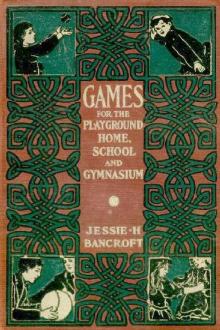Games for the Playground, Home, School and Gymnasium by Jessie Hubbell Bancroft (top novels of all time .txt) 📕

- Author: Jessie Hubbell Bancroft
- Performer: -
Book online «Games for the Playground, Home, School and Gymnasium by Jessie Hubbell Bancroft (top novels of all time .txt) 📕». Author Jessie Hubbell Bancroft
This is one of the best running games for the schoolroom. As in all such games, seated pupils should strictly observe the rule of keeping their feet out of the aisles and under the desks.
Players must observe strictly the rule of running forward on the right-hand side and backward in the next aisle, else there will be collisions.
CLAM SHELL COMBAT2 to 30 players.
Out of doors; seashore.
Each of the players is provided with an equal number of clam shells; the players then pair off in twos for the combat. Which of the two shall have the first play is decided by the players each dropping a clam shell from a height of three feet. The one whose shell falls with the hollow or concave side down has the first play. Should it be a tie, the trials are repeated until one player is chosen in this way. The play then opens with the unsuccessful player putting a clam shell on the ground, when the opponent throws another shell at it, trying to break it. If he succeeds, the opponent must put down another shell. This is kept up indefinitely, until a player's shells have all been won by the opposing thrower, or until the thrower fails to hit a shell, or his own breaks in doing so. Whenever one of these things occurs, he loses his turn, and must put down a shell for the opponent to throw at. The player wins who retains an unbroken shell the longest.
Where there is a considerable number of players, they may be divided into opposing parties, the players stepping forward in turn at the call of their respective captains.
This is a Korean game, reported by Mr. Culin.
CLUB SNATCH10 to 60 players.
Playground; gymnasium.
This is one of the best competitive chasing games.
A goal is marked off across each end of the playground. Midway between the goals, an Indian club is placed; a handkerchief or other similar object may be used, placed on some support—on a stake driven into the ground, laid over a rock or stool, or hung on the end of a branch. A stone or dumb-bell laid on the ground may be substituted. In line with the club a starting base is marked on each goal line.
The players are divided into two equal parties, each having a captain. Each party takes its place in one of the goals. The object of the game is for one of the runners to snatch the club and return to his goal before a runner from the opposite goal tags him, both leaving their starting bases at the same time on a signal. The players on each team run in turn, the captains naming who shall run each time.
The captains toss for first choice of runners; the one who wins names his first runner, who steps to the running base, whereupon the competing captain names a runner to go out against him, trying to select one of equal or superior ability. Thereafter the captains take turns as to who shall first designate a runner.
When there is a large number of players, or very limited time, a different method may be used for selecting the runners. All of the players should then line up according to size, and number consecutively by couples. That is, the first couple would be number one, the second, number two, the third, number three, etc. The couples then divide, one file going to one team and the other to the opposite team. The players run thereafter according to number, the numbers one competing, and so on. Each player may run but once until all on the team have run, when each may be called a second time, etc. To avoid confusion, the players who have run should stand on one side of the starting base, say the right, and those who have not run, to the left.
The first runners, having been called by their respective captains to the starting bases, run on a signal; the players may reach the club together and go through many false moves and dodges before one snatches the club and turns back to his goal. Should he succeed in reaching the goal before the other player can tag him, his team scores one point. Should he be tagged before he can return with his trophy, the opponent scores one point. The club is replaced after each run. In either case both players return to their original teams.
When each runner has run once, the teams exchange goals and run a second time. The team wins which has the highest score at the end of the second round.
For large numbers of players there may be several clubs, each having corresponding starting bases on the goals, so that several pairs of runners may compete at once. One club for twenty players, ten on each side, is a good proportion. For young players the club may be placed nearer one goal than the other at first, as shown in the diagram.
This is a capital game as here developed with the feature of scoring, and may be made very popular.
COCK STRIDE3 to 15 players.
Playground; gymnasium.
This game is usually played with boys' caps, but knotted handkerchiefs or balls of crumpled paper may be used. One player is the cock; he is blindfolded and stands in a stride position with his feet wide apart sideways. The other players stand in turn at a point five to ten feet behind him, and throw their caps forward as far as possible between his legs. After the caps are all thrown, each player moves forward and stands beside his own cap. The cock then crawls on all fours, still blindfolded, until he reaches a cap. The player whose cap is first touched at once becomes an object of chase by the other players, who are at liberty to "pommel" him when he is captured. He then becomes cock for the next round of the game.
CROSSING THE BROOK5 to 60 or more players.
Playground; gymnasium; schoolroom.
This game is a great favorite with little children. A place representing a brook is marked off by two lines on the ground. For little children in the first year of school (about six years old) this may start with a width of two feet. The players ran in groups and try to jump across the brook. Those who succeed turn around and jump back with a standing jump instead of a running jump. On either of these jumps the player who does not cross the line representing the bank gets into the water and must run home for dry stockings, being thereafter out of the game. The successful jumpers are led to wider and wider places in the brook to jump (a new line being drawn to increase the distance), until the widest point is reached at which any player can jump successfully. This player is considered the winner.
This game is printed by kind permission of the Alumni Association of the Boston Normal School of Gymnastics, from the book One Hundred and Fifty Gymnastic Games.
CROSS TAG5 to 30 or more players.
Playground; gymnasium.
One player is chosen to be It. He calls out the name of another player, to whom he at once gives chase. A third player at any point in the chase may run between the one who is It and the one whom he is chasing, whereupon this third player becomes the object of the chase instead of the second. At any time a fourth player may run between this player and the chaser, diverting the chase to himself, and so on indefinitely. In other words, whenever a player crosses between the one who is It and the one being chased, the latter is at once relieved of the chase and ceases to be a fugitive. Whenever the chaser tags a player, that player becomes It. Considerable sport may be added to the game by the free players trying to impede the chaser and so help the runner,—getting in the way of the former without crossing between the two, or any other hindering tactics.
DO THIS, DO THAT10 to 60 or more players.
Playground; gymnasium; schoolroom; parlor.
All the players stand facing one of their number who is the leader. The one who is leader assumes any gymnastic position or imitates any action, at the same time saying "Do this!" and the others immediately imitate. Should the leader at any time say "Do that!" instead of "Do this!" any player who imitates the action performed must be seated, or pay a forfeit, whichever form of penalty has been decided on at the beginning of the game. Three mistakes of this kind put a player out of the game, even when forfeits are the penalty.
The leader may choose any gymnastic positions that are familiar, such as chargings, head bendings, trunk bendings, arm movements, knee bendings, hopping, jumping, dancing steps, etc.; or imitate familiar actions such as hammering, sawing, washing, ironing, sewing, stone cutting, shoveling, riding horseback, etc.
DOUBLE RELAY RACES10 to 100 players.
Schoolroom; playground; gymnasium.
First two rows (Nos. 1 to 14) stand in aisle II and give way to rear to starting point. Third row (Nos. 15 to 21) stand in aisle III, march forward and around to right into aisle I, bringing entire 21 pupils into formation, as indicated for Team A on diagram. Fifth and sixth rows (Nos. 22 to 35) stand in aisle VI and give way to rear to starting point. Fourth row (Nos. 36 to 42) stand in aisle V, march forward and around to left into aisle VII, bringing entire team, Nos. 22 to 42, into formation as indicated for Team B on diagram.
First RelayAt commands, "Ready, go!" Nos. 1 and 22, the two leaders of the two teams, walk to wall in front of them at W/A and W/B, touch the wall, return down aisles III and V respectively, and continue up aisle IV to teacher's desk. When the two leaders, 1 and 22, touch the wall, Nos. 2 and 23 start at the "exchange points," X and X, 1 and 2 touch left hands across desks, and 22 and 23 touch right hands across desks. At the starting point, 1 touches left hand of 3, who starts as soon as touched, 22 touches right hand of 24, who also starts as soon as touched; so on to the last of each team, who finish the game by touching the desks where the leaders started. Both teams then "about face" and march back, Team A through aisles III, II, and I, and Team B through aisles V, VI, and VII, when they are ready for the next relay.
Same as First Relay, but this time running.
Same as Second Relay, but this time each leader starts with an eraser, if in the schoolroom, or a dumb-bell in playground, in his hand and gives it to the next pupil at "exchange point," each successive pupil repeating the exchange at that point. The third and succeeding pupils must wait at





Comments (0)